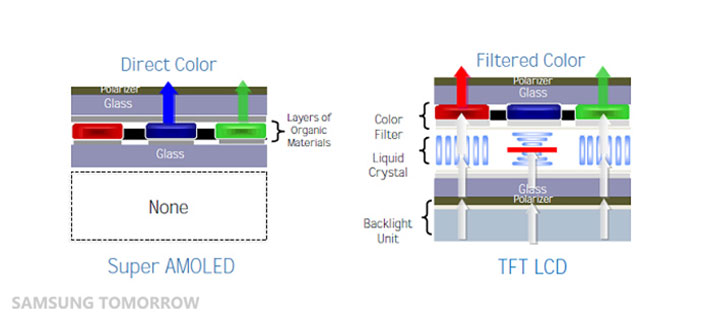By now, we’re coming to a new paradigm shift in the display, especially in those for smartphones. It is, more or less quickly, going from LCD screens to those AMOLED screens trying to optimize to improve their use.
If the medium and long-term is difficult to predict the superiority of AMOLED, in the world of mobile devices (smartphones, tablets) and wearable (smartwatch and gadgets for fitness), in the short term is not at all obvious what the right choice. Or, to put it another way: if we have to buy a better screen today, AMOLED or LCD? Which is the best? What is the most suitable?
AMOLED and LCD: A comparison of color and brightness
The first thing to keep in mind is the brightness of the colors, the most vibrant and alive in the LCD compared to AMOLED. The problem arises from the different technology used: The screens light up in ” one go “, if I may say so, all the pixels, the AMOLED instead illuminated a pixel at a time. This makes it more difficult, expensive and complex to maintain high levels of brightness on the screen. Even the colors are affected, especially the whites, in LCD more natural than the AMOLED.
This in general, then in practice there are some AMOLED screens, especially those used in the latest high-end Samsung smartphone, able to compete on equal terms with the best LCD. Not by chance are called SuperAMOLED have a better rendering of colors and brightness more intense. Brightness which also serves, but not only, to make the screen visible under the light of the sun. And this is one of the most serious weaknesses of AMOLED: under the direct light are virtually unreadable, unlike the LCD. But it is also true that all display manufacturers are working to resolve it.
AMOLED and LCD: An energy issue
If these differences were only the question of a comparison would not arise either. Just to be clear, if you are thinking of buying a TV or monitor for PC, then you should not even worry too much about the differences between the two displays, and focus directly on the LCD. But there is one key feature that pushes towards the development and improvement of AMOLED screens in mobile devices: energy saving. Because?

Well, because an AMOLED screen illuminates only the pixels used, the others are off. Which means that if a pixel is black, then it does not consume electricity, and consumed himself less quickly wear out more slowly over time. Incidentally, the question of usury in the AMOLED screens is still critical: after about a year, a year and a half, the current AMOLED panels tend to become worn and damaged. Even this you are having great improvements, and new AMOLED screens have a longer life.
The best is …
What is the strength of the AMOLED, a lower battery consumption and thus the possibility of having devices that can get through the day safely, it also defines why it is better to have an AMOLED screen on smartphones and smartwatch. Ultimately devices to carry around is preferable to increase autonomy at the expense of fewer bright colors.

